Car Insurance Add-Ons
Each state in the U.S. has set minimum levels of liability coverage that every driver must carry. Besides, you can buy additional protection and car insurance add-ons that will give you ancillary protection. What elements should you consider getting addied onto your policy?
FREE Auto Insurance Comparison
Secured with SHA-256 Encryption
Each state in the U.S. has set minimum levels of liability coverage that every driver must carry. Besides, you can buy additional protection and car insurance add-ons that will give you ancillary protection. Not every add-on is worth buying. Some may be duplicate items, such as rental car insurance, that you might already have with your credit card plan. Let’s go through 5 items that you should consider getting added onto your policy.
ARTICLE GUIDE
Uninsured Drivers Protection
For those motorists that don’t reside in one of the several no-fault states, if a driver that has no insurance hits you, you will not be covered. This is where uninsured motorist add-on coverage comes in. If you get into an accident and the other party has no coverage, you will still be insured.

Your insurance will kick-in after the deductible up and to the limits of the policy. If you don’t have it, you would need to go to court to try and recover damages. In this scenario, considering the person most likely cannot afford auto ins, probably won’t have the funds to settle with you. On average, adding it on will cost about 10% of the premium. So if you are paying $100 per month, your payments would be increased by only $10 to $110 monthly. This is a small investment to avoid being stuck with thousands in damages with no way of being reimbursed.
Gap Insurance
If you have a new vehicle that is heavily financed, you should look into adding gap insurance onto your policy. It will protect you, in the event, your car is totaled, and the insurer pays you a fair value amount that is below what you still owe on it. Almost all insurance carriers use basic valuation methods to determine your automobile’s worth when it’s wrecked. This is the amount they will payout, and it is non-negotiable.
Gap auto insurance pays for the difference in the amount owed and what is received from the insurer. For example, say your truck is two years old, and you have a loan remaining with the bank for $29,000. Your trucks hit and totaled in a serious accident. Your insurer then appraises your truck at $25,000. Gap insurance would later pay for the $4,000 gap. For new and leased cars it might make sense to add it on. If you buy a used car and get a good deal on it, then you most likely don’t need gap auto ins coverage.
Roadside Assistance
If your car ever breaks down on a hot summer day out in the middle of the desert, you will be glad you purchased roadside assistance. This add-on provides service in the event your vehicle breaks down anywhere in the U.S. and often Canada. This includes common items such as a dead battery, running out of gas, key lock-outs, and flat tires.
If the vehicle cannot be fixed, it will be towed to the nearest reliable mechanic. If you often travel long distances, like a traveling salesperson, then it is good to have. Also, if you have children and an older automobile, then it is recommended. However, you might be already covered through a spouses AAA plan, or the vehicle’s manufacturers own roadside assistance plan.
The Vanishing Deductible
You might have seen a commercial touting the vanishing deductible and not sure what it is. It’s often an added on an item with full coverage car insurance policies. If you can shop around and get it cheap enough, then it might be worth it. This option reduces your deductible at a fixed amount (normally $50 – $100) when the policy starts.
Then, during subsequent years it subtracts that amount from the deductible until it becomes zero. Thus the name, “vanishing deductible.” If you get into a wreck, then you can save some money with a lower deductible, or even a zero-cost one. Keep in mind though that there are some contingencies. If you get a ticket or are involved with an at-fault accident, it might void it. Analyze the extra cost and see if it’s right for you.
Personal Injury Protection (PIP)
Personal injury protection or PIP is added on coverage in most states, but not all. It gives extra coverage to you and also your passengers, after a car accident. It kicks in no matter who was at fault for the wreck. It’s often referred to as “no-fault” for this reason. Some states such as Texas make it mandatory as part of their state minimum car insurance requirements. With medical costs going up each year, it is an option to consider carefully.
The Bottom Line
While car insurance add-ons can help you out a lot, especially after an accident, they also cost extra. Many insurance agents will try to sell them as necessary, but take your time and do your due diligence. Some you will never use and others you might not even need. However, review each one and add-on the extra coverage items you find to be worth it.
Let the companies fight for you. Get a Quote!
Compare Quotes From Top Rated Insurers. Good Drivers Can Get Good Discounts. See How Much You Can Save Now!
Secured with SHA-256 Encryption


